Summary
Unlock the power of a journey map as we delve into their role in refining user experiences, smoothing transitions, and ensuring external factors don’t compromise the sensation—your guide to crafting seamless and user-centric journeys!
Definition
As defined by NNg, a journey map is “a visualization of the process that a person goes through in order to accomplish a goal” (Gibbons, 2018). Let’s clarify, for experienced designers, this tool isn’t meant solely to fix processes; its primary aim is to enhance the overall user experience. Additionally, it serves as a valuable instrument for measuring the success of UX initiatives.
A journey map not only elaborate on collateral information but also organizes actions into a logical sequence of events for designers.
The key is to consider that the mere thought about a product, a service or any offer, is already an engagement with such offer, and the thought after consuming such an offer, is still an active engagement. Maybe this engagement is not as tangible as the action at the point of transaction, but it’s an engagement at last. Think about it, before visiting a restaurant, you have a very clear idea of what you want, an expectation is set; and the restaurant owner, would do anything to meet that expectation. The graphic below proposes that we reduce the uncertainty of delivering a top-notch experience and take a step further, imagining (before you get reliable data), what could have created that thought to engage with the offer in the first place (what was the “situation that hatched that thought”).
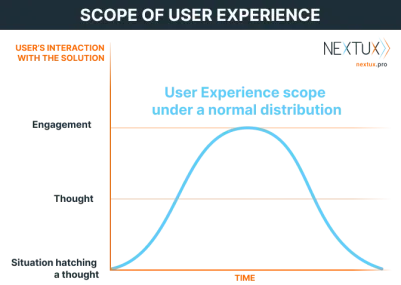
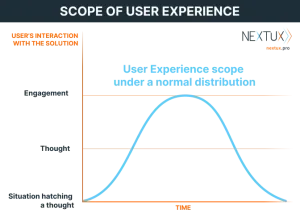
By thinking like this, the scope of user experience is defined through a wider range of empathy with the end user; inevitably we must start thinking about their needs, their circumstances, environment, behavior, and overall ecosystem in which these ideas come to mind. It all comes together when the designers of the solution track back the steps the consumer took to get to the point of transaction. By creating a customer journey map, and tracking back to the “thought-hatching” step of the engagement, the gaps and wins of the user experience quickly surface, showing the opportunities to fine-tune and elevate your offer and differentiate it from competitors.
“It’s not about the process, it’s about the experience.”Emil Aliev
For User Experience professionals, prioritizing the enhancement of the process isn’t the primary goal—unless the specific task involves improving the experiential aspect of the process. The process functions as a foundation for the staged experience, and rectifying the process may not necessarily guarantee an improved experience. However, enhancing the experience is likely to have (potentially positive) repercussions on the process. The end user naturally indicates the path that feels most intuitive to them; the designer’s role is to ensure this ‘path of least resistance’ is smoothed out to align with experiential expectations.
The taxonomy of the journey map should address key experiential questions: Who is the individual embarking on this journey? What is the contextual backdrop for this journey? What milestones or essential steps define the progression? How does each stage impact the individual, and what is their predisposition toward each step? Ultimately, how can we enhance and refine this journey for an optimal user experience?
Basic template
In this diagram, there are three primary swimlanes. The first two focus on the end user, while the bottom one encapsulates the desired outcome for the design teams.
Who is the person undertaking this journey?
Persona
On its own, a Persona is a design tool crucial for UX as it offers the essential perspective from the end user’s point of view. It comes with its distinct parameters and demands research for precise calibration. It goes beyond a mere user group; instead, it should distill the essential specifics for the human group the solution aims to serve. This serves as the starting point, establishing the context for all subsequent considerations in the journey map. If you haven’t crafted a detailed Persona based on actual research for your business, at the very least, comprehend the distinct characteristics of the broader groups of people your solution is targeting. A simplified example could be ”creative teenager, Kristina.”
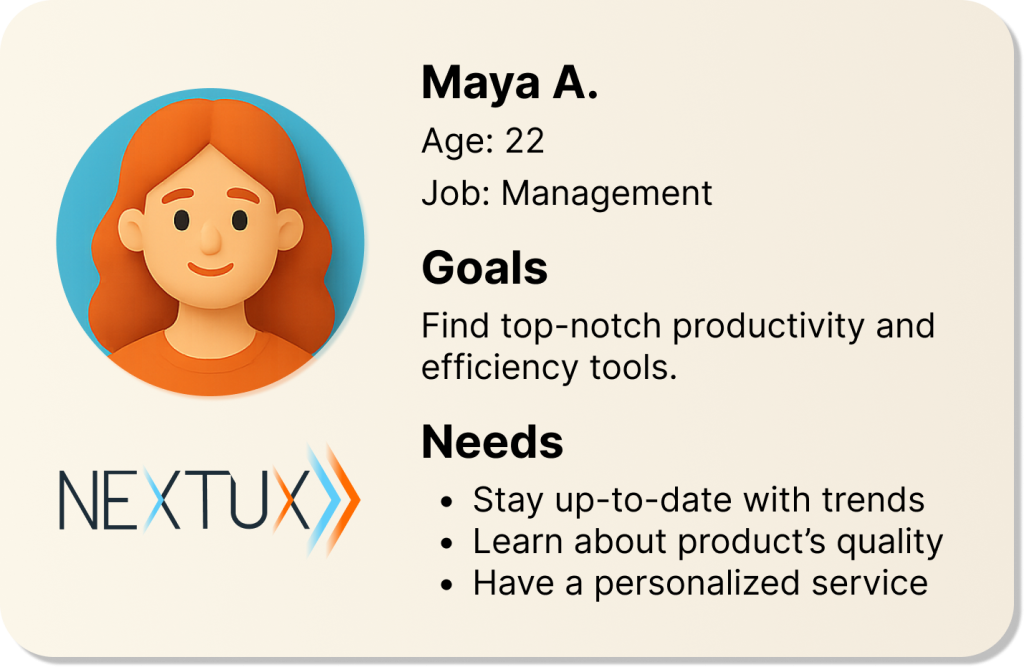

In what setting or circumstances does this journey take place?
Scenario
In addition to the Persona, the working teams must comprehend the broader context. Scenarios delineate the situation, incorporating all essential attributes to establish context and foster greater empathy for the end user. Design teams should delve into diverse scenarios, recognizing their potential impact on goal completion and the corresponding user experience. For instance, quickly buying something on a small phone is very different from taking your time on a bigger device like a computer.
While ideal scenarios may align with the delivery team’s goals, the design process should mitigate risks by exploring and testing across various scenarios.
How does the journey affect the person, and what is their initial attitude or inclination?
User’s top goals
What are the primary goals the end user aims to accomplish in this journey, and what expectations do they have while fulfilling these objectives?
It’s crucial to emphasize that these goals pertain to the end user, distinct from the business goals, although they might align. The focus here is solely on enhancing the end user’s experience, irrespective of business objectives, fostering a deeper sense of empathy. Business goals are typically addressed in a separate diagram, such as a service blueprint, or are implicitly understood by the design team, and not explicitly described on the journey map.
A common question when creating a journey map is: How can we align business goals and end users’ goals in a journey? Ideally, they should coincide in the context of supply and demand, but this alignment isn’t always guaranteed.
As an example, in a straightforward resale website, the business aims to sell products, aligning with the end user’s goal of making a purchase. Here, goals naturally coincide, guiding the design of a unified solution for buying and selling. However, when the end user is casually browsing, the business goal diverges from the user’s goal, especially if the primary business objective is sales rather than product showcasing. In such cases, the business may still strive to engage the customer, providing an optimal browsing experience to potentially lead to a sale or, at the very least, to capture attention for brand exposure and other marketing purposes (as a store benefits from people being in the store).
What are the key milestones or essential steps that the Persona must go through to successfully finish the journey?
Phases, steps, milestones
It establishes logical divisions in the journey from the end user’s perspective. When refining the experience, the progression from one phase to another should be intentionally designed, considering the end user’s expectations. The end user may not perceive the phases as distinctly separated, as illustrated on the diagram—some transitions could be swift, taking only a few seconds, like with a 1-click purchase button, while others may span days, extending the journey’s completion timeline.
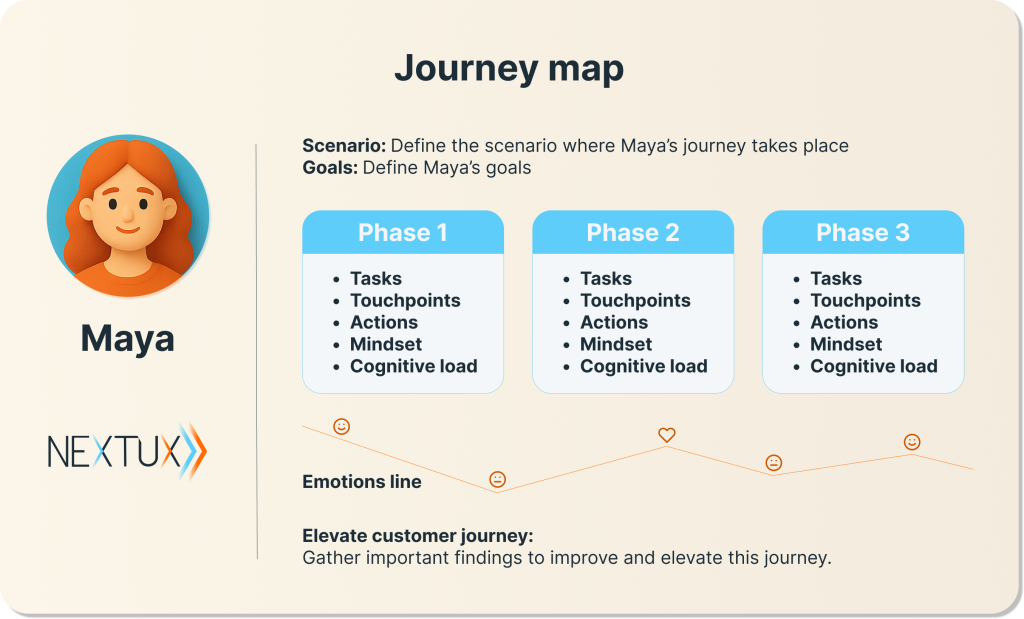
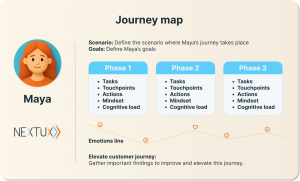
Each phase should encompass actions, mindset, and emotions. The ideal data for this comes from field research, empathizing with the end user.
- Actions: A list of behaviors necessary to complete each phase.
- Mindset: Describes what the end user is thinking during interactions with the solution.
- Emotion: Traced through the journey timeline as a thread, it illustrates the spectrum from frustration to delight.
- Cognitive load: Similar to the emotion thread, it spans the entire journey, gauging the number of concurrent tasks presented to the end user. This includes factors like user interface noise, distracting marketing at the point of transaction, and overall interface busyness.
How can we enhance or optimize this journey?
Let’s elevate the customer journey.
Gather important findings to improve and elevate this journey. Clearly define each item, designate potential ownership, and suggest necessary outcomes aligned with user needs.
Conclusion
Journey map tools are valuable for various experiences, including product sales, service delivery, and experiential products. Learn more about the categories of experiences in our “What is user experience” article.
While it’s crucial for design and working teams to illustrate the end user’s journey as a process, the primary aim of the journey map is to refine the experience, not the process itself. It serves to streamline transitions between steps, particularly when switching solutions is necessary for task completion. The goal is to safeguard the sensation of the experience from external factors and prevent counterproductive visibility of backend processes.
References
Gibbons, S. (2018, December 9). Journey Mapping 101.Nielsen Norman Group. https://www.nngroup.com/articles/journey-mapping-101
Aliev, E. (2024, April 21). What is user experience?
NextUX. https://nextux.pro/articles/what-is-user-experience/
